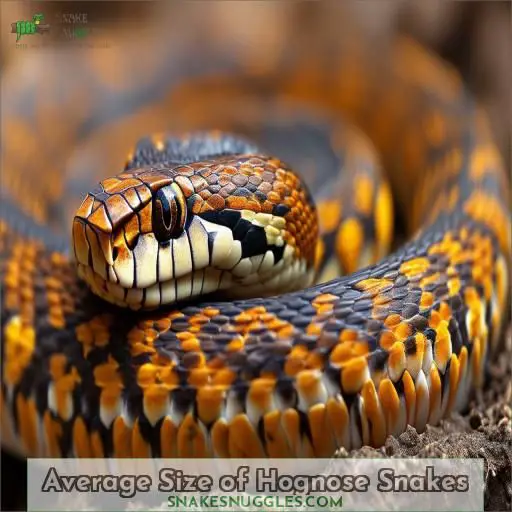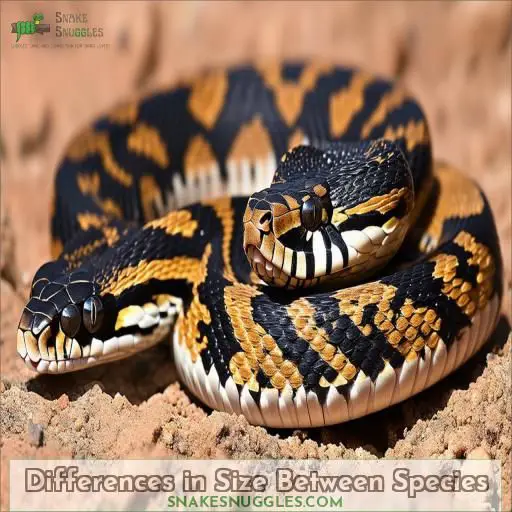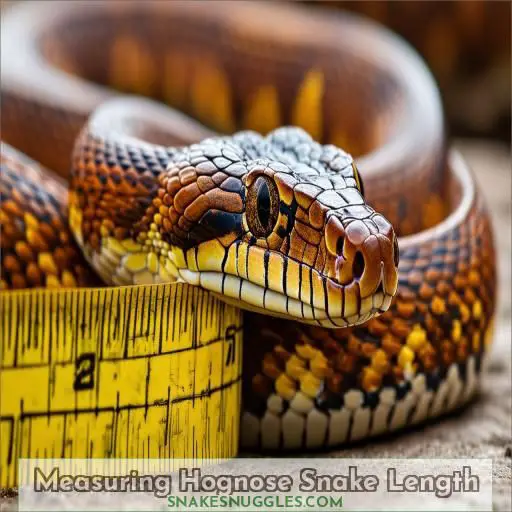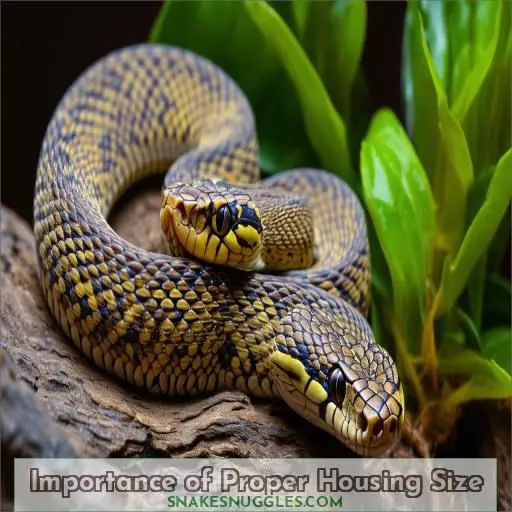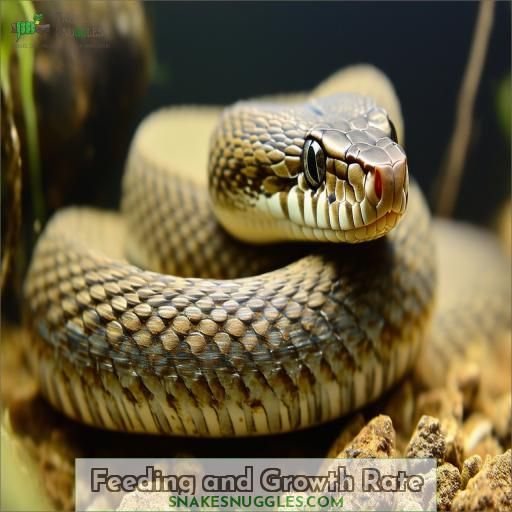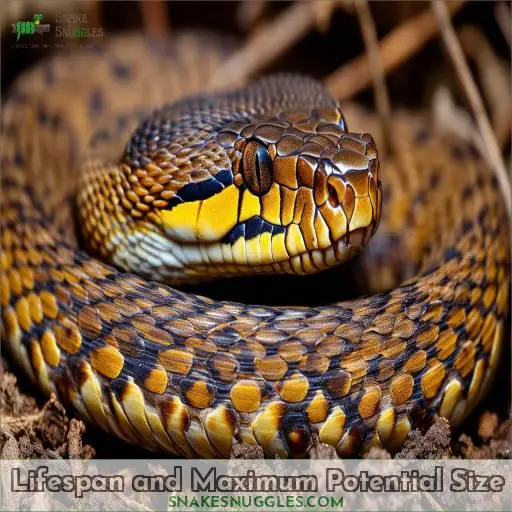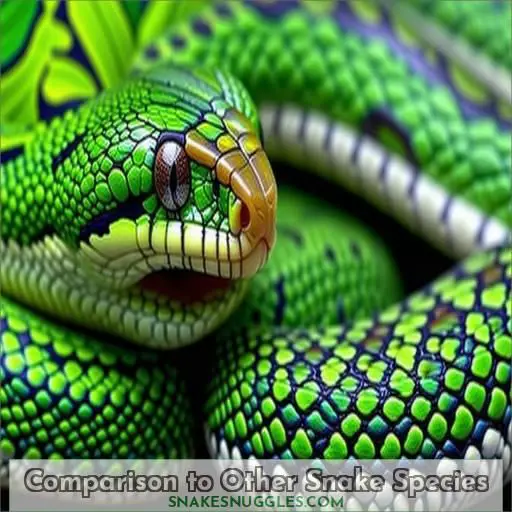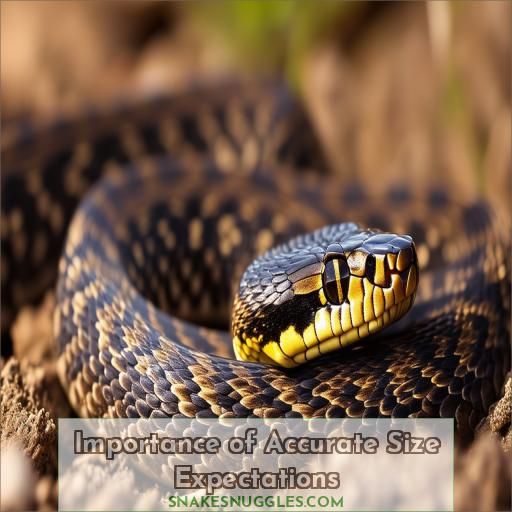This site is supported by our readers. We may earn a commission, at no cost to you, if you purchase through links.
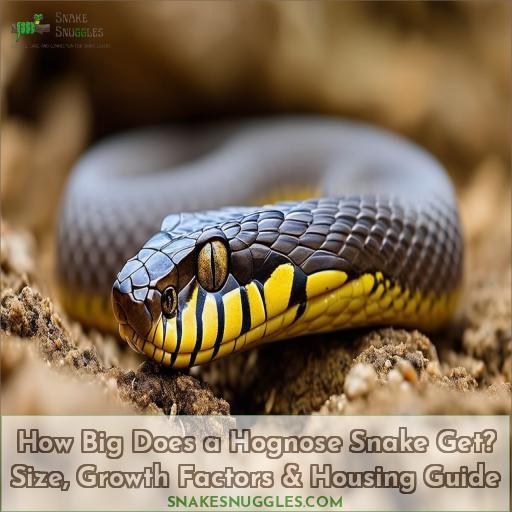
Generally, hognose snakes are medium-sized constrictors, reaching lengths of 60-80 cm (24-31 inches) as adults.
However, size varies depending on the species – western and eastern hognoses max out around 80 cm, while the smaller southern hognose tops out around 61 cm.
Factors like sex, genetics, diet, and environment affect their maximum size potential.
Proper housing that allows adequate thermoregulation and movement is essential for achieving full growth.
To learn the ideal enclosure dimensions and feeding regimen for maximizing your hognose’s size…
Table Of Contents
- Key Takeaways
- How Big Does a Hognose Snake Get?
- Average Size of Hognose Snakes
- Factors Affecting Hognose Snake Size
- Differences in Size Between Species
- Measuring Hognose Snake Length
- Importance of Proper Housing Size
- Feeding and Growth Rate
- Sexual Dimorphism in Hognoses
- Lifespan and Maximum Potential Size
- Comparison to Other Snake Species
- Importance of Accurate Size Expectations
- Frequently Asked Questions (FAQs)
- How big is a full grown hognose snake?
- Are hognose snakes good pets?
- Do hognose snakes like to be handled?
- Can a hognose snake hurt you?
- How long does it take for a hognose snake to reach its full size?
- Is there a difference in size between captive-bred and wild hognose snakes?
- Can hognose snake size vary based on geographic location or climate?
- Do hognose snakes continue growing after reaching sexual maturity?
- How can you ensure proper growth and maximum size for your hognose snake?
- Conclusion
Key Takeaways
- Hognose snakes are the middle-weight champions of the snake world – not too big, not too small, just the right "Goldilocks" size. Imagine a muscular little python that could bench-press a few mice!
- While genetics set the stage, factors like diet, habitat, and even your snake parenting skills play a major role in determining whether your hognose reaches its full size potential. It’s like raising a kid – all the right ingredients are needed for them to become a strapping adult.
- Don’t let their compact stature fool you – hognose snakes pack a hefty bite for their size! These toads-gone-wild hunters have evolved some serious chompers to take down amphibious prey. It’s the tiny terrors you gotta watch out for!
- When housing these burly little serpents, think "tiny titan" and size up accordingly. Nothing cramps a hognose’s style like an enclosure that’s too small for its big snake dreams. After all, you want your scaly buddy living large, not cramped up like a sardine.
How Big Does a Hognose Snake Get?
How big does a hognose snake get? Most hognose snake species reach an average adult length of 2-4 feet, with some variation based on factors like sex, diet, and genetics. Females tend to be larger than males in this medium-sized, heavy-bodied snake species.
Average Size of Hognose Snakes
Hognose snakes are known for their moderate size, with adult males and females showing noticeable sexual differences. Hatchlings typically measure between 15-20 cm (6-8 inches) in length .
As they grow, western and eastern hognoses, the most common species, generally reach 60-80 cm (approximately 24-31 inches) in length (Source). However, southern hognose snakes are smaller, maxing out at around 61 cm (24 inches).
Environmental influences like housing and diet also play roles in their final size, highlighting the importance of proper care. Adequate hognose snake terrariums and appropriate feeding practices help them achieve their full growth potential and maintain good health.
Factors Affecting Hognose Snake Size
Various factors influence the size of hognose snakes, including their species, sex, diet, genetics, and environmental conditions . Females generally grow larger than males, and adequate nutrition alongside favorable habitat conditions is essential for reaching maximum growth potential (Source).
Species (eastern, Western, Southern, Etc.)
Hognose snake size varies by species: eastern (60-80 cm), western (60-80 cm), and southern (up to 61 cm) hognoses, reflecting geographic distribution and inherent variations .
Sex (females Tend to Be Larger Than Males)
In hognose snakes, sex differences are prominent: females typically outgrow males in weight and size, influenced by genetic factors and environmental impact (Source).
Diet and Nutrition
A proper diet notably impacts hognose size. Providing appropriate prey types and frequency fuels growth. Toad venom immunity allows feedings.
Genetics
Genetics plays a pivotal role in determining a hognose snake’s Potential size. Selective breeding and inbreeding impact genetic diversity and trait expression.
Environmental Conditions
You’d think genes alone control size, but environmental factors hugely impact hognose snake growth. Consider:
- Humidity levels
- Substrate choice
- Heating gradients
- Lighting requirements
- Ventilation needs
Provide the right habitat, and watch them thrive!
Differences in Size Between Species
While most hognose species average 60-80 cm (24-32 in) in length, there are noticeable size differences between them. Eastern and western hognoses tend to be the largest, with westerns potentially reaching around 80 cm (32 in). The southern hognose is smaller, maxing out around 61 cm (24 in).
| Species | Average Length (cm) | Max Length (cm) |
|---|---|---|
| Eastern | 60-75 | 80 |
| Western | 60-80 | 80 |
| Southern | 45-61 | 61 |
Mexican hognoses are similar in size to westerns. Regional variations and subspecies like the dusty hognose may also impact adult length.
Measuring Hognose Snake Length
To accurately measure your hognose snake’s length, you’ll need:
- A flexible tape measure or string
- A flat, straight surface
- Patience and gentleness
Carefully stretch your snake out on the surface, keeping it calm. Measure from the tip of the snout to the vent in a smooth motion. Don’t add pressure – just gently straighten any curves. Newborns are around 6-8 inches, but growth rates vary by species, diet, and environment. Regularly measuring helps track development and makes sure your snake’s enclosure fits its increasing size. Captive hognoses sometimes outgrow wild counterparts, so stay vigilant. With practice, length measuring becomes quick and stress-free for you both.
Importance of Proper Housing Size
Providing the appropriate housing for your hognose snake is essential for its well-being and growth. As these snakes grow, their space requirements expand. An adult hognose needs an enclosure with a minimum length of 3-4 feet and width of 18-24 inches. However, a young hognose can start in a smaller enclosure like a 20-gallon tank.
| Snake Age | Min. Tank Length | Min. Tank Width |
|---|---|---|
| Hatchling | 10-12 inches | 6-8 inches |
| Juvenile | 24-30 inches | 12-18 inches |
| Adult | 36-48 inches | 18-24 inches |
Appropriate housing allows proper thermoregulation, humidity levels, and space to move freely, promoting overall health and growth. Upgrade to a larger enclosure as your snake matures.
Feeding and Growth Rate
You’ll need to feed your hognose snake appropriately sized prey items 1-2 times per week to support healthy growth. Overfeeding, even with appropriately sized prey, can lead to obesity and other health issues, so it’s important to closely monitor your snake’s body condition and adjust feeding accordingly.
Feed Appropriately Sized Prey Items 1-2 Times Per Week
Feeding your hognose snake appropriately sized prey items 1-2 times per week is essential for proper growth. Offer a variety, such as:
- Frozen/thawed mice or rats
- Appropriately sized feeder insects
- Pre-killed fish or amphibians
Vary prey to promote health. Scent training can encourage feeding in captivity. Monitor growth closely to adjust feeding frequency.
Overfeeding Can Lead to Obesity and Health Issues
While 1-2 appropriately sized feedings per week promote healthy growth, overfeeding can quickly lead to obesity and associated health issues. Excess weight strains organs, restricts movement, and increases risks like fatty liver disease. To maintain your hognose’s svelte figure, resist overfeeding – it stunts neither size nor lifespan when fed responsibly.
Sexual Dimorphism in Hognoses
One key area of Sexual dimorphism in hognose snakes is their size—females tend to grow larger and stouter than males of the same species. Additionally, male hognoses often possess longer, thicker tails compared to females, an adaptation that aids in breeding.
Females Tend to Be Larger and Stouter Than Males
You’ll notice sexual dimorphism in hognoses – females tend to be larger and stouter than males. This size difference likely evolved to aid reproduction; larger females can produce more offspring. When housing hognoses, provide sufficient space for your female’s larger size. Proper husbandry supports healthy growth to their full potential.
Males Often Have Longer, Thicker Tails for Breeding Purposes
You’ll also notice that male hognoses tend to have longer, thicker tails compared to females of the same species. This reproductive size difference helps males grip the female during breeding behaviors. When housing male and female hognoses together for breeding purposes, account for the males’ longer tails when determining appropriate enclosure size.
Lifespan and Maximum Potential Size
The maximum potential size a hognose snake can reach depends on a combination of genetic factors and the environmental conditions it’s raised in. By providing appropriate housing, a varied and nutritious diet, and maintaining ideal temperature and humidity levels, you’ll allow your hognose to achieve its full growth potential.
Reaching Their Full Potential Size Depends on Many Factors
Reaching their maximum potential size depends on various factors. Hognose snakes can vary considerably, with:
- Species differences (eastern vs. western)
- Sex (females tend to be larger)
- Environmental conditions (heating, humidity)
Ensuring proper care allows your hognose to reach its full growth potential. Size variation exists, but handling and heating play key roles.
Genetics, Nutrition, and Environment All Play a Role
To reach their maximum size, genetics, nutrition, and environment are pivotal. Their inherited genetic makeup lays the foundation, while an appropriate diet and habitat conditions nurture their full growth potential.
| Genetics | Nutrition | Environment |
|---|---|---|
| Inherited traits | Prey quality/quantity | Heating, UVB, substrates |
| Species/lineage | Balanced diet | Humidity, ventilation |
| Individual variation | Hydration levels | Enclosure size |
Comparison to Other Snake Species
While hognose snakes are classified as medium-sized snakes, they’re distinct from many other species due to their robust, heavy-bodied build. Unlike more slender snake species, hognoses have a stocky, muscular physique that allows them to burrow and hunt effectively in their natural habitats.
Hognoses Are Considered Medium-sized Snakes
Compared to many snakes, hognoses are considered medium-sized – but there are significant size variations based on species and regional differences. While females exhibit sexual dimorphism by growing larger, exceptional individuals of certain species can exceed typical length ranges. Understanding a hognose’s size and housing needs is essential for responsible care.
But Hognoses Have a More Robust, Heavy-bodied Build
While hognoses may be medium-sized snakes, they certainly don’t lack girth. Compared to other species, hognoses have a more robust, heavy-bodied build that allows them to:
- Burrow and excavate with ease
- Strike with incredible force when threatened
- Subdue and consume large prey items
- Retain heat efficiently in cooler climates
This thick-bodied shape is just one of the many adaptations that make hognoses so unique.
Importance of Accurate Size Expectations
Having appropriate size expectations is essential when caring for a hognose snake. Their adult length can vary greatly depending on species, sex, and other factors like genetics and environment.
An eastern hognose may reach 60-80cm, while the smaller southern species tops out around 61cm. Underestimating their potential size could mean housing them in an enclosure too small for an adult. Inversely, overestimating means wasting space and resources.
Gauge their growth rate and adjust housing accordingly. The differences between subspecies also affect eventual size, so research your specific snake’s habits and needs.
With proper husbandry, your hognose can achieve its full, healthy potential size.
Frequently Asked Questions (FAQs)
How big is a full grown hognose snake?
A full-grown hognose snake reaches 60-80 cm (24-31 inches) in length. These heavy-bodied serpents pack a mighty punch in a compact package – perfect for their toad-munching lifestyle!
Are hognose snakes good pets?
With up to 80% kept as pets not surviving a year, hognoses require experienced reptile care. Though relatively small at 60-80 cm, their specialized diets and environmental needs make them challenging yet rewarding pets for the dedicated hobbyist.
Do hognose snakes like to be handled?
You may find hognose snakes aren’t fond of frequent handling. As semi-fossorial snakes, they prefer burrowing over cuddling. With patience and positive reinforcement, though, they can become accustomed to gentle interaction.
Can a hognose snake hurt you?
Can a hognose snake hurt you? You bet – though rarely life-threatening, their upturned snouts can deliver a surprisingly potent bite. But don’t worry, these dramatic "hognose hoaxes" just want to be left alone.
How long does it take for a hognose snake to reach its full size?
You can expect a hognose snake to reach its full size in around 3-5 years. Proper care, including appropriate temperatures, humidity levels, and diet, plays an essential role in promoting healthy growth rates.
Is there a difference in size between captive-bred and wild hognose snakes?
You’ll find wild hognoses are typically smaller than their captive counterparts. While wild adults usually max out around 60-75 cm, well-fed captives can reach over 90 cm in ideal conditions.
Can hognose snake size vary based on geographic location or climate?
Curious about hognose snake sizes? Their length can indeed vary depending on their geographic location and climate. In cooler regions, these reptiles tend to be slightly smaller, while hotter climates may produce larger specimens.
Do hognose snakes continue growing after reaching sexual maturity?
Yes, hognose snakes continue slow growth after reaching sexual maturity. Though they typically only attain modest sizes around 2-3 feet long as adults.
How can you ensure proper growth and maximum size for your hognose snake?
To facilitate proper hognose snake growth, provide adequate enclosure size, appropriate temperatures, varied diet with calcium/vitamin supplements, and low stress. Consistently fulfilling their specific environmental and nutritional requirements allows hognoses to attain their full potential size.
Conclusion
While modest in size, understanding how big a hognose snake can become is essential for providing appropriate housing.
Averages range from 60-80 cm. Yet factors like species, sex, diet, and environment influence their maximum potential.
With ideal setups facilitating thermoregulation and mobility, these robust constrictors can flourish and attain their full, genetically predetermined size.
Comprehending size expectations guarantees you provide your hognose with the space it requires.

